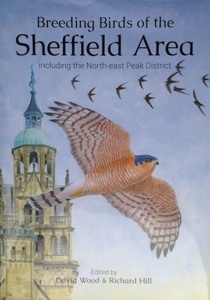Birds Near and Far
Home books dvds apps sites extra maps links contact us blog Buy
Birds Near and Far
Home books dvds apps sites extra maps links contact us blog Buy
10th March 2014
Breeding Birds in the Sheffield Area
The new book by David Wood and Richard Hill ‘Breeding Birds in the Sheffield Area’ is one of the most fascinating bird books I’ve seen in years - and not just because I’m from Sheffield too. It comes at a time when lots of local societies are publishing the results of tetrad atlases but this one comes with two added features. Firstly the results of their survey, between 2003 and 2008, can be compared with the results of a previous survey in 1975-80. The comparisons show up in the superbly presented maps which are ingeniously designed to show, for each species, which tetrads have been deserted (grey blobs) or colonised (green blobs) since the previous survey. It really is amazing to see how many of the maps have striking patterns of green or grey; so much change in distribution in just 30 years.
I imagine that some of the other local atlases will also be able to demonstrate similar patterns of change. But the second thing that makes this book especially informative is the fact that the Sheffield Area is so clearly divided into upland and lowland. Basically the western half of the area is where the upland areas are in the Dark Peak and White Peak wheareas the eastern half is entirely lowland areas around the valleys of the Don and the Rother. So each map shows at a glance what has been going on in both upland areas and lowland areas - the maps are so easy to interpret.
What’s more, like the proverbial buses, we now have new information arriving from other sources too. Another tetrad atlas was organised in Derbyshire in 1995-99 and the results of that survey have just been published too, in the whopping great tome that is the magnificent Birds of Derbyshire by Roy Frost and Steve Shaw. The significance for us in Sheffield is that about half of the area covered by Wood and Hill is in Derbyshire so we have yet another basis for comparison.
Meanwhile, believe it or not, there have been two other tetrad surveys carried out in the Sheffield Area. The first was in 1988-90 when I organised a survey for the Sheffield Bird Study Group. This was simpler than other tetrad surveys in the sense that it only asked participants to provide details of one 1-hour count in each tetrad; they were invited to do an hours walk and count all the birds they saw or heard. To my shame I never managed to publish the results of that survey - until now. Suddenly those results have taken on a greater significance because when the BTO organised their recent Bird Atlas (2008-11) they also asked birders to make 1-hour counts in as many tetrads as possible. The BTO have agreed to pass me those results for the Sheffield area so that their ‘timed tetrad visits’ (TTVs) can be directly compared with the results we got in 1988-90.
The results of this analysis were published in British Birds
Gosney D. (2015) Changing numbers of breeding birds in the Sheffield area. Brit Birds. 108:66-79
A blog by Dave Gosney about some of the birds and places that feature in his books and DVDs but also about the state of birds in the Sheffield area

